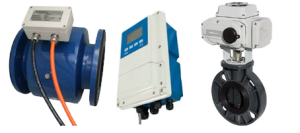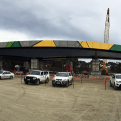Using SCADA for Adaptive Irrigation Management – Understanding SCADA
Part One of Four – Understanding SCADA
First a quick introduction
Around the world, SCADA systems are commonplace in water and energy utilities as well as manufacturing facilities, also increasingly used in medium to large-scale irrigation automation applications.
Utility operators in sectors such as water and wastewater utilities typically have monitoring and control sites spread over a wide geographical area. These utilities interact with a wide range of devices using a varied range of communications types.
This network footprint is very similar in Municipal and Agricultural applications.
So, what is SCADA?
Supervisory Control And Data Acquisition (SCADA) is an industrial strength automation platform that is at the heart of a lot of modern industries and has been the mainstay of automation systems around the world for decades.
SCADA systems are used both by private operators and public-sector service providers. SCADA works well in many different types of applications because it can be a very compact and simple configuration right through to very large and complex projects.
Actually, almost anywhere you look in today’s industrial world, park, local supermarket, nearest hospital, at the manufacturing plant where your neighbour works, or the district wastewater treatment plant, there is most likely some type of SCADA system running things behind the scenes.

What are the key parts of a SCADA System?
In the overall structure of a SCADA system, there are four distinct levels, these being:
- The field equipment such as machines, instruments, and actuators
- The PLCs and / or RTUs
- The communication network
- The SCADA host software
How does a SCADA System Work?
All SCADA systems integrate multiple software and hardware elements that, once installed will allow the system operators to:
- Monitor, collect and process data from local and remote devices
- Interact with, and control machines and equipment such as valves, pumps or motors
- Record and export events
In most SCADA architectures, data from sensors inputs are sent to RTUs (remote terminal units), which then send that information to other local or remote computers that host the SCADA software. The SCADA software analyses and displays the data using it to complete algorithms which will then deploy commands for remote equipment to complete very complex operations.
Well-designed and properly deployed SCADA systems can result in significant operational savings in time and money, and significant environmental saving in water and energy.
Let’s take a quick look at field equipment
“You can’t control what you don’t measure”.
It’s an old adage, and it means that the right instrumentation is a key component of a safe and optimised control system.
Traditionally, pumps and their associated operational equipment would have been manually controlled, meaning the operator would start/stop pumps locally and valves are opened/closed by hand.
Slowly over time, this machinery would have been fitted with a range of sensors, such as flow and pressure instruments, and actuators such as relays and solenoids, allowing the operator to remotely operate and manage the equipment.
Connecting the field equipment to your SCADA
Today, most field devices such as valves are fitted with actuators, enabling a PLC or RTU to control the device rather than relying on manual manipulation.
Once connectivity for these field devices has been established and integrated into local PLC or RTU, to relay data to SCADA host software, and applications written, the goal of automation can be achieved.
This capability means the control system can react more quickly to optimise production or shutdown under abnormal events, or even predict events based on known parameters.
Wait, what are PLC’s and RTU’s?
Programmable Logic Controllers (PLCs) are small industrial computers designed to automate customised control processes.

On the other hand, a remote terminal unit (RTU) is a multipurpose device used for remote monitoring and control of various devices and systems for automation.
RTU’s are typically deployed in industrial environments and they serve a similar purpose to programmable logic circuits (PLCs) but to a higher degree.
Knowledge base and skillsets
Although today’s instrumentation technician requires much more technical knowledge and the ability to design, install and maintain equipment compared to the past, this is offset by reduced costs in automating processes and higher technical skills held by personnel.
Ensuring you have fit for purpose equipment
In many applications, the field equipment is also required to function in very harsh environments. Many types of equipment is specifically designed for the extremes of hot and cold.

If the instrumentation is not designed for these temperatures, an artificial environment within a cabinet or some sort of building is required. This comes at an extra cost, not just in initial deployment but also for ongoing maintenance.
Compliance
The equipment must also comply with any EMC (electromagnetic compatibility) standards which may be in place, to ensure that an electrical device does not have any undesirable effects upon its environment or other electrical devices within its environment.
Next chapter – Irrigation Automation using SCADA (coming soon)




